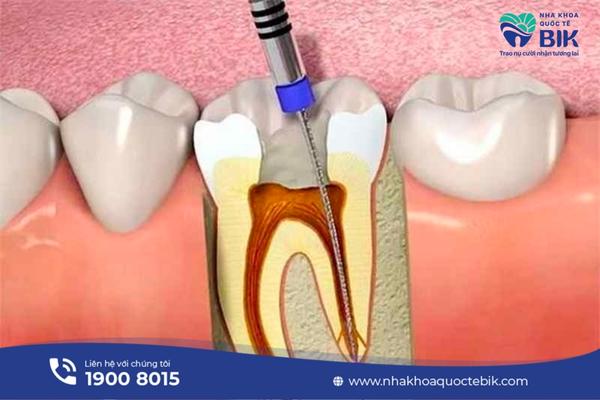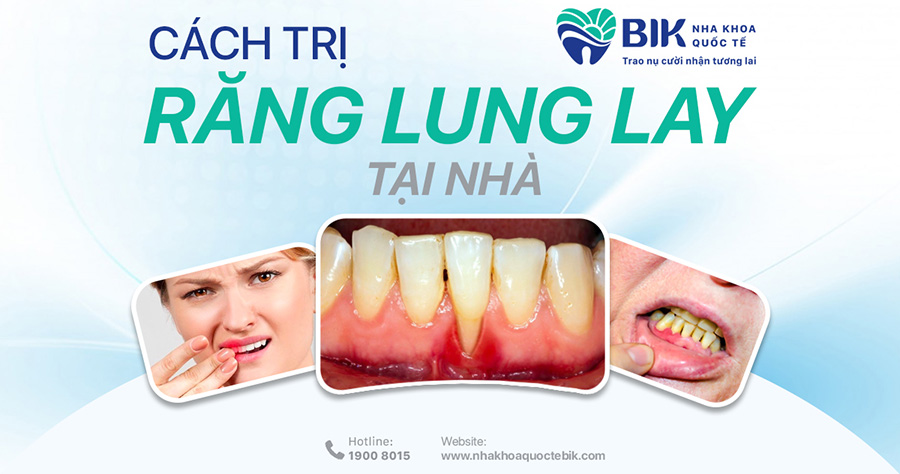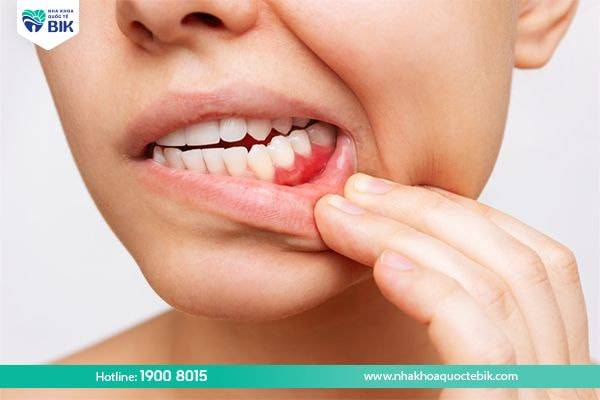Tooth decay to the pulp is a serious stage of tooth decay. Therefore, recognizing the signs of tooth decay to the pulp is extremely important so that you can detect and treat it promptly. Let’s find out some signs and complications that can occur when tooth decay reaches the pulp through the following article with BIK International Dentistry!
1. What is tooth decay to the pulp?
First of all, you probably need to learn about the structure of a complete tooth. The tooth will include 3 main components, of which the pulp is the innermost part, containing important nerves and surrounded by dentin and enamel on the outside.
Tooth decay to the pulp is a condition when the tooth is attacked by harmful bacteria that attack the tooth structure. At that time, the hard tissue of the tooth will gradually wear away and form holes on the tooth surface. If not treated promptly, the tooth will penetrate deep into the pulp, causing pulpitis, also known as pulpitis.
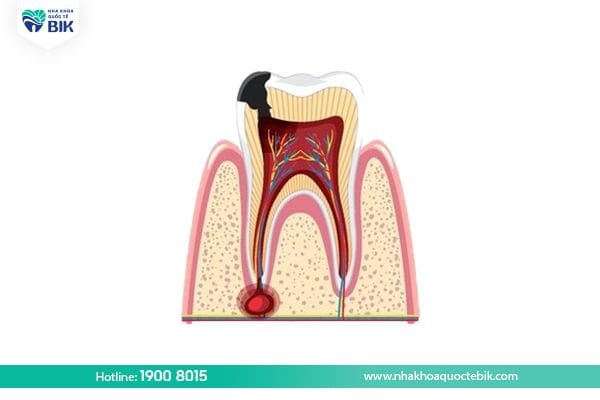
2. Signs of pulpitis
There are some common symptoms of pulpitis, which are divided into stages:
2.1. Signs of early stage pulpitis
When pulpitis is in the early stages, the patient will feel more pain when eating and drinking hot or cold foods and drinks, or even when breathing cold wind or air with changes in pressure. You may try to avoid it by chewing on the side that is not painful, because the level is still mild and unclear, so this stage is often overlooked.

2.2. Signs of tooth decay reaching the pulp in the second stage
When reaching this stage, your teeth will experience more pain. The pain can be dull and last for a long time in one area, lasting all day, or it can also be severe in attacks that spread to the nerves in the head. When using pain relievers, it can only be slightly relieved or not relieved.
At this point, the pain tends to spread to the whole area, making it difficult for you to determine where the tooth is aching. The pain seriously affects the patient’s sleep and ability to chew, thereby affecting their health and daily activities.

2.3. Signs of tooth decay reaching the pulp stage later
In the later stage, it means that the tooth decay is very severe, has spread to the pulp and can kill the pulp. That is also the reason why at this stage, many patients no longer feel pain even though they have not been treated. The mouth will have a bad smell due to food remaining in the cavity. Gingivitis around the decayed tooth and surrounding teeth will cause pain for the patient.
After a while, the tooth may even break or fracture due to bacteria attacking the hard tissue of the tooth. You may see white spots on the gums, pus pockets or pus flowing out of the gum areas around the tooth root, causing the tooth to loosen, and the face may be swollen. At this stage, the tooth may or may not be painful depending on whether the pulp is dead or not.
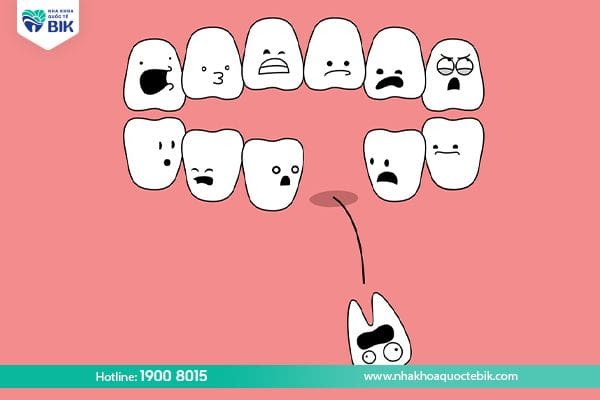
3. Complications of tooth decay
If tooth decay to the pulp is not treated promptly, it can cause many serious complications. Some complications include:
– Tooth decay to the pulp causes gingivitis around the tooth root.
– Can cause bad breath due to food residue left in the cavities that are not cleaned combined with gingivitis around the tooth root.
– Inflammation appears: When food debris remains in the cavities, it will combine with pathogenic bacteria to form inflammation. Once the bacteria penetrate deep into the pulp, it will cause pulpitis, causing pain to the patient.
– In addition, tooth decay into the pulp is also dangerous when the inflammation forms pus, causing facial swelling, loose teeth, and abscesses at the tooth tip.
– The inflammation spreads to cause jawbone inflammation, creating nearby infections, destroying the jawbone, affecting the nervous system and blood vessels in the body.
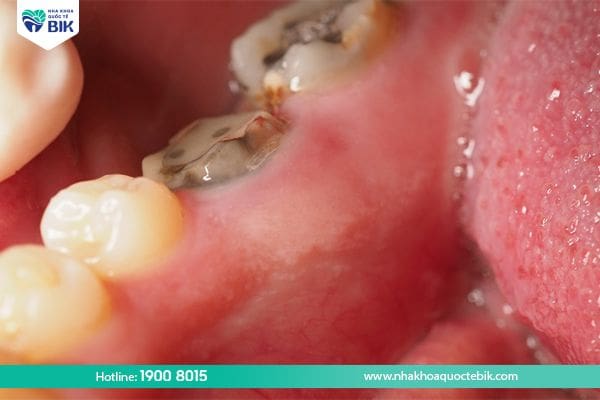
4. Is tooth decay into the pulp really dangerous?
If tooth decay into the pulp is not treated early, it can cause worrying consequences. Some dangerous problems that patients may encounter are as follows:
– Long-term tooth decay without treatment will create cavities as well as cause teeth to crack and break, forming places to store leftover food, causing bad breath.
– Pulpitis can lead to periodontal gingivitis, apical abscess causing extreme pain and discomfort. It can even cause facial swelling for many days, affecting health as well as daily work.
– Tooth decay that reaches the pulp will gradually kill the pulp, completely destroy the body and root of the tooth, and cause permanent tooth loss.
– In addition to killing the pulp and losing the tooth due to decay, this disease can also cause decay and infection in the adjacent teeth.
– Pulpitis can lead to inflammation of the jawbone.
– Inflammation in the jawbone caused by complications of tooth decay will create a favorable environment for bacteria to reside in patients with cardiovascular disease, diabetes, etc. This will make the patient’s condition worse and more difficult to control.
– Not only causing serious consequences for oral health, tooth decay also makes eating and drinking difficult, thereby causing physical and mental weakness.
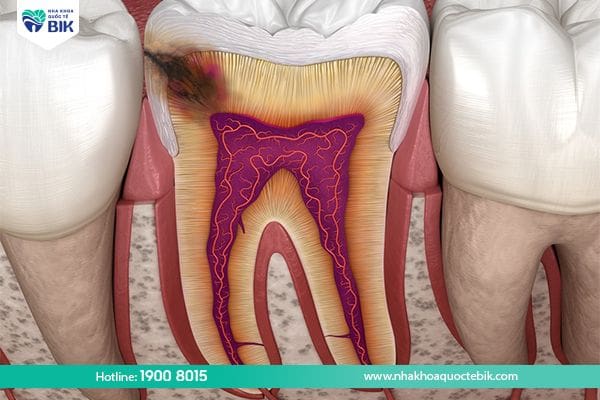
5. How to treat tooth decay reaching the pulp
If the dentist diagnoses the tooth as having decay reaching the pulp or has begun to show complications due to tooth decay reaching the pulp, depending on the actual condition, the dentist will prescribe appropriate treatment methods. Specifically, some treatments are as follows:
5.1. Root canal treatment
Root canal treatment is the most common treatment. The dentist will perform anesthesia to avoid pain when opening the pulp chamber, removing infected pulp in the pulp chamber and root canals. The root canals are cleaned with irrigation and shaped to facilitate irrigation and filling of the root canals. The tooth body will be reshaped and finally a porcelain crown will be placed to protect the tooth and restore chewing function as well as aesthetics to the tooth.
5.2. Re-treatment of the root canal
If the patient experiences a case where after root canal treatment the infection at the root canal still occurs or does not go away, the dentist will have to re-treat the root canal. The procedure for re-treatment of the root canal is similar to that of root canal treatment. The only difference is that the dentist will have to remove all the filling material in the root canals before cleaning the root canals again before re-filling the root canals.

5.3. Cutting the apex of the tooth
Before performing the apex cutting procedure, you will be anesthetized by the dentist to feel comfortable during the treatment. The dentist will cut the gums, remove the bone to expose the infected tooth tip. The infected area and the root inside the infected area will be completely removed. The root canal in the remaining root will be sealed with a specialized filling material. Depending on each case, the hole in the bone can be filled with artificial bone. Finally, the dentist will suture the mucosa that was cut at the beginning.
5.4. Tooth extraction
The first thing the dentist will do is anesthetize you so that you do not feel pain during the tooth extraction process. Using appropriate tools, the tooth will be extracted. At the same time, the infection at the tip of the tooth will also be removed. Make sure that the extracted tooth is not bleeding before leaving. The patient will also be prescribed medication and given instructions for post-extraction care by the dentist. Making dentures to maintain chewing function as well as aesthetics is necessary.
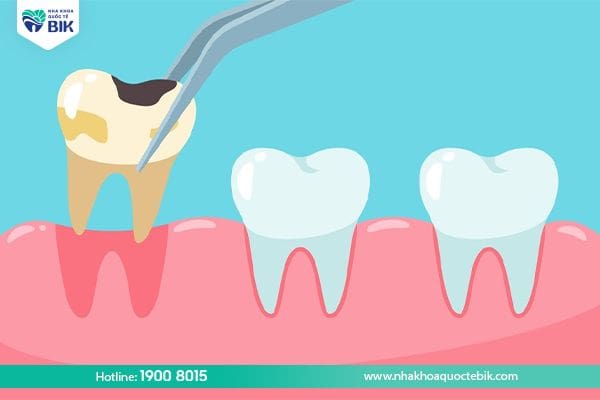
Thus, the signs of tooth decay reaching the pulp will be divided into 3 different stages depending on the severity. At each stage, there will be different corresponding signs. Patients need to know these signs to detect and treat this disease early because they can cause serious complications and consequences. You can choose BIK International Dental Clinic as a reliable treatment place with a team of specialized doctors with rich experience in the profession.

